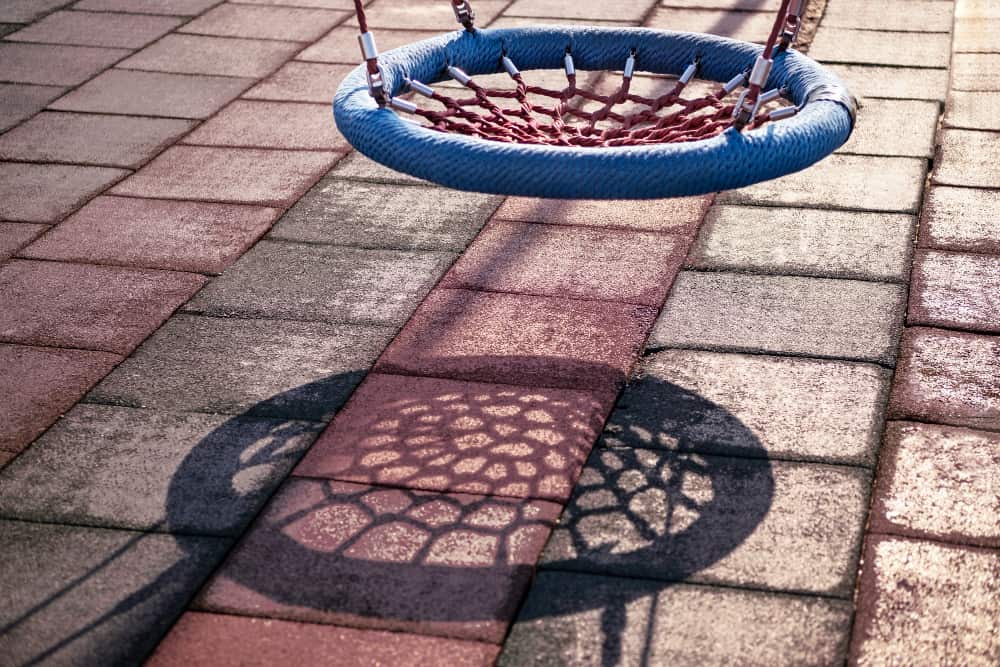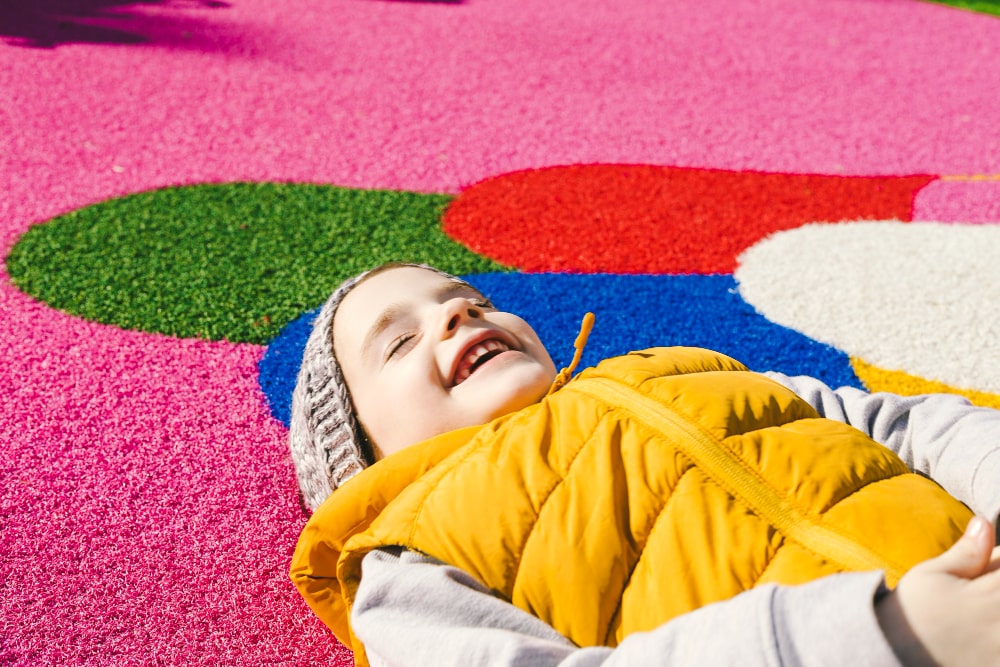How Much Does Poured-in-Place Rubber Cost?
DECEMBER 15, 2023
- What Is An Average Rubber Surfacing Cost Per Square Foot?
- What Are the Benefits of Using Poured in Place Rubber for Surfacing?
- Factors Affect the Cost of Poured in Place Rubber Surfacing
- Where Poured Rubber Surfacing Can Be Used?
- Bonus: Rubber Surfacing Cost Comparison
- How to Save on Poured-in-Place Rubber
- Is Poured-in-Place Rubber Worth the Investment?
When planning a playground project, selecting floor covering materials is one of the key aspects, besides choosing a location and playground equipment. It’s also crucial to ensure safety surfacing without breaking the budget. And poured-in-place rubber works well in this case, providing durability, slip-resistance, versatility, and fall cushioning, meeting both environmental and safety standards.
So, how do you ensure you don’t drain your pocket when installing or replacing the existing surface? We have prepared a detailed guide on poured-in-place rubber playground surface cost to make the process of planning and choosing rubber surfacing materials easier for you. Read on to find out how much does rubber cost to find the perfectly balanced option.
What Is An Average Rubber Surfacing Cost Per Square Foot?
When calculating the potential playground surface cost, pay attention to playground size. If you have an area with the square footage of 1000 or larger, you can expect a poured-in-place rubber cost per square foot in the range of $12-16 per sq ft. Here, you can see a ballpark figure of the budget you should plan, considering the average cost for a 1,000-square-foot playground:
| Average cost | Highest Cost | Lowest Cost |
| $14,000 | $16,000 | $12,000 |
However, if you’re going for a smaller playground, note that it’ll be more expensive. The initial cost may range from $16 to $25 per sq ft, plus the cost to install a new surfacing.

What Are the Benefits of Using Poured in Place Rubber for Surfacing?
Generally speaking, such a type of flooring may offer several benefits:
- Rubber is a low-maintenance and easy-to-repair material
- Rubber lasts for years without continual resurfacing
- High-quality PIP is the longest-lasting rubber safety surface on the market
- Rubber is an ADA (the Americans with Disabilities Act Standards for Accessible Design) compliant material
- Rubber prevents slipping and falling
- Rubber can be installed both indoors and outdoors, from water parks and playgrounds to patios and interior spaces
- PIP rubber can be completely customized, using various color granules
The rubber surfacing cost is a perfect balance between quality and durability
Factors Affect the Cost of Poured in Place Rubber Surfacing
Here are some of the key aspects affecting the poured-in-place rubber cost:
Material Quality
The quality of the material and rubber granules are among the main factors. For example, EPDM has higher elasticity than TPV, but costs 20% more. Another thing to keep in mind is that rubber surfacing is usually made of two layers (an aggregate foundation and a rubberized top layer), and the aggregate foundation cost may range from $3 to $6 per sq ft.
Also, the bonding agent affects the price; for example, aromatic glue is more economical than aliphatic adhesive.
Thickness and Coverage Area
Rubber thickness is another aspect to consider. The deeper your poured-in-place rubber is, the more raw material required, so the more material the higher the cost. The PIP flooring is usually made up of a wear layer (at least 9″ thick) and a base layer (of 1-10″ thickness). Fall height requirements of surfacing correlate with its thickness, so having enough depth provides excellent shock absorption and reduces the probability of a serious injury.
Coverage also affects rubber surfacing cost, namely, larger areas usually have a lower price due to savings on materials, equipment transportation, and labor costs. So, for smaller wet pour rubber surface projects, you may have to pay more for materials.
Design Complexity
More complex designs can increase the wet pour rubber cost. So, the more patterns, colors, and design variations you would like to use in your project, the higher the price will be.
Also, choosing the color of a rubber for your playground is a double-edged sword. On the one hand, all-black rubber attracts and accumulates too much heat under direct sunlight. On the other hand, colored rubber can be up to four times more expensive than black rubber.
Installation Location and Conditions
Installation conditions can change the price. Site preparation may require the removal of existing materials or debris, which increases labor costs. Another consideration is your location; the more rural the area, the more expensive the transportation. These pricing factors can significantly affect the price, which in some cases can be $9 per square foot or $18 or more.

Where Poured Rubber Surfacing Can Be Used?
The poured-in-place rubber surfacing is well known for its versatility, granted by its convenience, lower maintenance costs, and safety. Besides playgrounds, amusement parks, and other high-traffic areas, this type of surfacing can be used in different projects, be it poured rubber for pool decks or patios, due to its slip-resistance, impact attenuation, durability, and easy cleaning. The poured rubber surface is also perfect for long-lasting driveways and can withstand heavy traffic. Thanks to all the earlier-mentioned properties, PIP can also be used for sidewalks.
Bonus: Rubber Surfacing Cost Comparison
One thing to remember when designing and planning to construct a playground is the budget. Nevertheless, remember that just because the product has a lower initial cost does not make it cheaper. Most of these affordable products may require extra maintenance, installing new pieces as the old ones wear out. These factors boost the costs in the future much more than buying quality products immediately.
| Playground surfacing type | Cost to install (per square foot) |
| Poured-in-place rubber (EPDM or TPV) | $12-16 |
| Rubber tiles | $6-20 |
| Rubber mulch | $0.80-1.20 |
| Rubber pavers | $2-6 |
Poured-in-place rubber cost
Rubber poured-in-place surfacing is one of the most trustworthy alternatives in spacious environments with intensive traffic flow. Depending on the playground size, poured-in-place rubber ranges between $12 – 16 (for larger spaces) and $16 – 25 per square foot for smaller playgrounds.
Rubber tiles cost
Rubber tiles are long-lasting, anti-slipping, and easy to install, making them the top choice for hundreds of playgrounds for many years. The cost of rubber tile surfacing is also related to its thickness, quantity per field, and quality but typically ranges from $6 to $20 per square foot.
Playground mulch cost
If cost-saving is what you want with less compromise on the quality of the playground, then rubber mulch, which is usually made of shredded pieces of recycled rubber, is an appropriate option for your playground. The installed cost for a sheet of mulch starts from $0.80 to $1.20 per square foot.

How to Save on Poured-in-Place Rubber
You can reduce rubber playground flooring cost if:
- Prepare the base yourself
- Buy materials in bulk
- Don’t overpay for excess thickness, if possible
- Plan the project in the low season
- Compare prices of EPDM/TPV rubber suppliers

Is Poured-in-Place Rubber Worth the Investment?
Ensuring that the play area is safe must always be the top priority. Nonetheless, it’s crucial to choose a cost-effective one. The best surface material is poured-in-place rubber, as it offers superior fall protection, passes almost any drop test, is adaptable, requires little maintenance, and could help you cut expenses.
When selecting the material for a playground surface, many may consider the initial installation cost only. Yet, long-term maintenance is a massive factor in the affordability of the material. Poured-in-place rubber requires nothing more than a rare cleaning to remove dirt or debris. Moreover, you are highly unlikely to need to replace your PIP surface sooner than 10-12 years after the installation.

